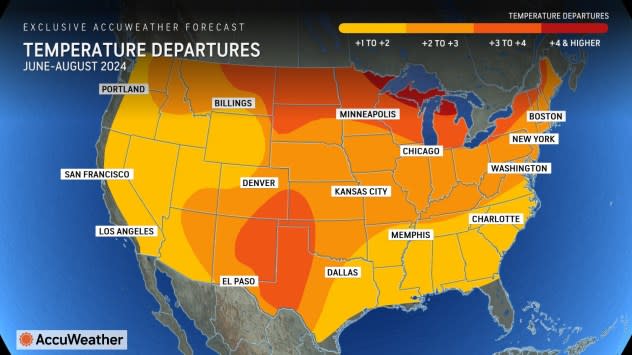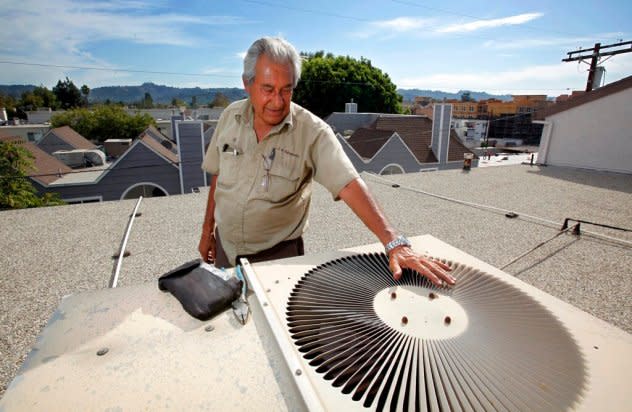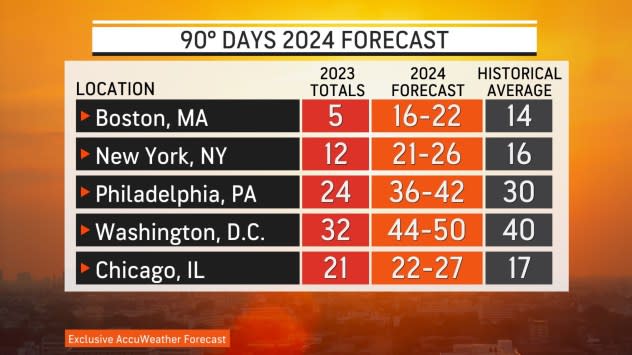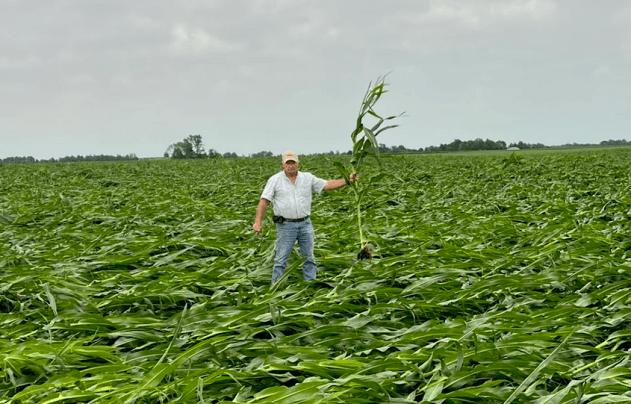Sizzling summer ahead: AccuWeather issues 2024 US summer forecast
Air conditioners will have their work cut out for them this summer as AccuWeather meteorologists say it is looking like a hot season for most areas of the United States.
Some regions have already had flashes of summerlike conditions, including Baltimore where the temperature reached 90 degrees on April 29, nearly one month ahead of schedule, and Phoenix, which had its earliest 100-degree day in six years.
 |
Young men jump from a 7.5 meter platform in an outdoor pool on Friday, July 3, 2015. (AP Photo/Michael Probst) |
Meteorological summer starts on Saturday, June 1, while astronomical summer begins nearly three weeks later on the solstice, which is at 4:50 p.m. EDT on Thursday, June 20, 2024. No matter how you slice it, the upcoming season is shaping up to be a hot one for most of the United States.
A hot summer is expected for nearly all of the contiguous U.S. with only a few exceptions. From June through August, temperatures are forecast to run at least 2 degrees above historical averages across more than half of the country.
 |
"Summer 2024 can feature heat waves for many areas across the Plains to Northeast," Pastelok said. "Compared to historical averages, the hottest areas can be over the Great Lakes, Upper Midwest and southwestern Plains." Showers and thunderstorms in these areas may bring periodic breaks in the heat in June and July, but drier weather could result in some of the hottest weather for the region in August.
The widespread warmth will translate to higher energy bills for homes and businesses across the country.
"Energy demand is expected to be higher compared to average," Pastelok said. "Air conditioners and other cooling devices will be in high demand."
 |
Even though the air coming out is pretty warm, Al Manzano, founder of A&M Refrigeration Co., cools his hand on the vent fan outlet on an air conditioning unit on the roof of an apartment building in the North Hollywood district of Los Angeles Tuesday, Sept. 28, 2010. (AP Photo/Reed Saxon) |
In New York City, there will likely be twice as many 90-degree days compared to last year when there were 12. In Boston, there could be three to four times as many 90-degree days this year compared to the five recorded in 2023.
The mercury is predicted to hit 90 degrees more frequently than historical averages across many other Northeast cities, such as Washington, D.C., and Philadelphia, and areas farther west, including Chicago.
 |
Showers and thunderstorms will help to curb excessive heat across the Gulf Coast states, the opposite of the pattern that emerged over the region last summer. Dry spells in 2023 helped boost temperatures and caused drought to expand, especially across Louisiana and coastal Texas.
While daytime high temperatures may not be far from historical averages, the humidity will consistently lead to very warm nights across much of the Gulf States.
Systems swinging through the Pacific Northwest will have a similar effect on temperatures, delivering showers and thunderstorms to the region periodically throughout the summer. This will reduce the chance of prolonged stretches of hot weather in places such as Seattle and Portland.
 |
This will be the second summer where the AccuWeather HeatWave Counter and Severity Index™ will be used. This unique index factors in the length and severity of a heat wave, helping to better inform and prepare people for scorching conditions.
Summer is synonymous with thunderstorms across the United States, and the anticipated heat will contribute to an uptick in severe weather.
"Severe weather events can be frequent in June and part of July," Pastelok said. This includes the risk of derechos, which are clusters of intense thunderstorms nicknamed "inland hurricanes" due to the widespread wind damage they cause and how they appear on radar.
A derecho generates winds over 58 mph across an area more than 400 miles wide but can unleash gusts over 100 mph-strong enough to flatten entire cornfields.
 |
Marty Marr, a farmer in New Berlin, Illinois, holds up a corn stalk that had been flattened by the derecho that charged through the Midwest on Thursday, June 29, 2023. (Twitter/@ilcorn) |
Across part of the West, the annual monsoon will be the driving force behind some summertime thunderstorms although it may arrive late this year compared to most years.
Typically, the monsoon season begins in mid-June, but this year, Pastelok said that it may not kick into gear until July. The height of the monsoon-induced storms is likely to occur over the West from late July through the first half of August before waning in September.
 |
Summer storms over the West can provide some heat relief but also raise the risk of flash floods and wildfire-igniting lightning strikes.
A thunderstorm does not need to be severe to be dangerous. Every year, around 20 people die and hundreds more are injured in the U.S. due to lightning strikes.
June, July and August account for the highest number of lightning-related deaths, according to an analysis from the National Lightning Safety Council. About one in three deaths were water-related, including people who were fishing, boating or at the beach. Experts recommend that when thunder roars, people should go indoors until the storm has passed.
A super-charged Atlantic hurricane season is in the offing, and the first storm of the year could spin up before the season officially begins on June 1.
"All indications are pointing toward a very active Atlantic Hurricane season in 2024," AccuWeather Lead Hurricane Forecaster Alex DaSilva added.
 |
This GOES-16 satellite image taken Saturday, Aug. 31, 2019, shows Hurricane Dorian, right, churning over the Atlantic Ocean. (NOAA via AP) |
AccuWeather meteorologists are forecasting 20-25 named storms across the Atlantic basin in 2024, including 8-12 hurricanes, four to seven major hurricanes and four to six direct U.S. impacts. This is all above the 30-year historical average of 14 named storms, seven hurricanes, three major hurricanes and four direct U.S. impacts.
"There is an increased flood threat for the Gulf States as a busy tropical season is anticipated with one or two threats in the summer season," Pastelok said.
 |
Tropical activity may ramp up around the same time as the wildfire season begins to escalate across the U.S. and Canada.
Drought conditions across the northern tier of the nation may contribute to an uptick in the wildfire threat. "This year, the worst of the smoke can be across the upper Great Lakes to the Northeast," Pastelok said. Click here to read AccuWeather's 2024 wildfire forecast, including how it will impact air quality across the country.
Want next-level safety, ad-free? Unlock advanced, hyperlocal severe weather alerts when you subscribe to Premium+ on the AccuWeather app. AccuWeather Alerts™ are prompted by our expert meteorologists who monitor and analyze dangerous weather risks 24/7 to keep you and your family safer.

 Yahoo News
Yahoo News 










